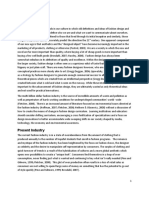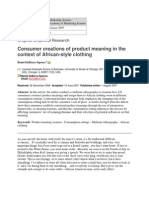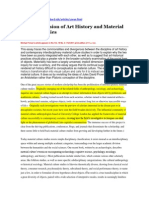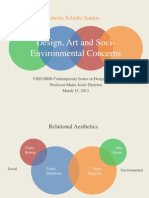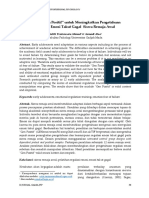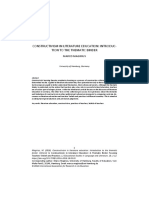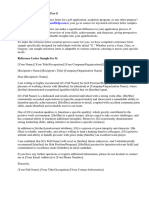Roberta Schultz Santos CADN 6C01 Prof.
Michael Prokopow November 11, 2013 PANTONE: How can products become propaganda and consumers advertisers? Introduction
Initially established as a tool for the practice of graphic design, the Pantone Matching System became popular for its innovative and accurate method for printing colours at industrial level, thus, facilitating the reproduction of shades and hues with an unprecedented precision. Since its creation in the 1960s, the Pantone Company has grown to become the worlds leade r in colour technology and trend forecast, establishing Pantone as one of the most influential brands in the field of design. This research is primarily concerned with the inception of the sub-brand Pantone Universe as a means to commercialize the idiosyncratic aspect of design practice. By analyzing the circuit of culture of Pantone Universe commodities, the present paper proposes an investigation of the overarching structures of brand strategies as reinforced by consumers and producers through a global process of validation from the symbolic to the real. It wishes to undertake the issues of group identity formation as moderated by self-regulatory standards of the global culture industry where cultural values are consolidated in a materialized form (Lash & Lury, 2007). To that end, this paper poses questions concerning the influence of new technologies and the media on contemporary branding practices. More specifically, it seeks to unveil the lionization of the internet as a driving force in the global process of class differentiation and as the instigator of new customer relations strategies. Furthermore, this research inquires if political structures and dominant modes of thinking are reproduced through industrial patterns of standardization while promoting hegemonic and homogenizing values to the populace. Is the cultural industry dominated by an
1
�illusion of freedom, like Adorno and Horkeimer foresaw? And is this illusion validated by brands such as Pantone and its numeric color system? Context It is a startling fact that a printing process has given origin not only to coffee mugs and tshirts, but to credit cards and hotels. However, the translation of a working tool into a diverse line of consumer goods was only feasible through the conception of Pantone as a producer of ideological change. Pantone Universe has become a vessel for the aesthetization of the design process in a period where design virtually ceases to be understood as a profession and starts to be conceived as a lifestyle choice. Accordingly, Pantone profits from the timelessness of the subject of colour in order to perpetuate a fading empire. As four colour printing technology evolves, and the reproduction of spot colours progresses to become increasingly more accurate, Pantone becomes more fragile as a brand, losing space and purpose in the global market, hence the necessity to re-invent itself within a distinct realm of production. The uniqueness of this case study lies on the uncommon transition that Pantone went through and the cultural context that allowed for this commercial move to happen. Pantone Universe encapsulates the zeitgeist of a consumer period dominated by technology and a quest for differentiation. Through the specificity of design, the brand proposes a worldwide lifestyle where individuals are connected by the suggestion of a differentiated taste as an alternative to the traditional socio-geographic modes of correlation. By purchasing Pantone Universe products, creating web-art that references the Pantone chips, staying at the Pantone Hotel in Brussels, or even wearing Pantone make-up, an individual is capable of concomitantly fulfilling desires of singularity and belonging. Pantone illustrates cultural and personal values which are not to be found inside the grand circuit of consumer culture. It represents the current youth mentality where originality is treasured while the
�mainstream is automatically discarded. Pantone epitomizes the identification of designers as a global class by becoming a social differentiator, a status symbol, and a personal insignia. With this research scope in mind, it is important to take into account that this investigation is invested in the scrutiny of the brand Pantone as a case study for the larger field. It is not intended as an exploration of other systems of colour classification; neither is it engaged with the themes of colour trend forecast, colour history or dye technology and production. Although this paper establishes links between colour and commerce, its primal focus does not lie in this field of research. Colour systems are considered a relevant part in the schema of factors and circumstances of the Pantone history, and even though, the author recognizes the merit of such subjects of study, due to the limited extension of this paper it is not possible to embrace all the pertinent topics that surround the Pantone Company. Methodology Despite of the ample range of simplistic books concerning colour theory and history that have referenced the name Pantone (Eiseman, 2000; Eiseman, 2006; Eiseman & Recker, 2011), there appears to be little to none academic research regarding the company from a theoretical perspective. In contrast, this paper proposes an investigation of Pantone under the light of the major disciplines of Design Theory and Cultural Studies. Its framework is rooted in theories of branding and globalization that advocate the conception of brands across contexts surpassing the methodological nationalism inherent of marketing and understanding the significance of the local and the global in the construction of brand meaning (Cayla & Arnould, 2008). The research structure it loosely based on the Circuit of Culture by Paul DuGay (1997), which offers a holistic understanding of a cultural artifact through the analysis of five distinct aspects related to its circulation, them being: representation, identity, production, consumption and
�regulation. Differently from DuGays book1, this paper is not organized according to each individual aspect; nonetheless, all categories are thoroughly addressed throughout the subsequent chapters of this research in a fluid and compliant manner. A recurrent term is the concept of Cultural Intermediaries by Pierre Bourdieu (1984), which refers to a group of professionals employed in the realm of symbolic goods and services. These are the people responsible for the production of the cultural industry and, to a certain extent, of our current reality. The notion of Cultural Intermediaries is extended to Matt Soars contemporary conception of designers as cultural intermediaries, individuals whose job it is to develop these forms to mediate between, or more properly, articulate, the realms of production and consumption (Soar, 2002).
Doing cultural Studies: The Story of the Sony Walkman, 1997.



